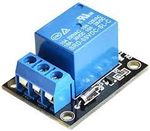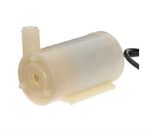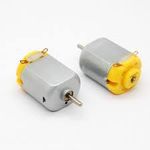DESIGN AND IMPLEMENTATION OF SMART HOME AUTOMATION USING INTERNET OF - IJCRT
←
→
Page content transcription
If your browser does not render page correctly, please read the page content below
www.ijcrt.org © 2021 IJCRT | Volume 9, Issue 3 March 2021 | ISSN: 2320-2882
DESIGN AND IMPLEMENTATION OF SMART
HOME AUTOMATION USING INTERNET OF
1
K.SivaPrakash, 2Subiksha Pattnaik, 3Krishitha R, 4Vashruthi J, 5Vibitha M
1
Assistant professor, 2Student, 3Student, 4Student, 5Student
1
Department of Electronics and communication Engineering,
1
KGiSL Institute of Technology, Coimbatore, India
Abstract: Home automation may be a topic which is gaining popularity day by day, due to large advantages. One are able to do
home automation by simply connecting household appliance electrical devices to the web or cloud storage. The reason for the
demand of home automation is reaching the pinnacle in recent days for its simplicity and comparable affordability. The biggest
disadvantage of a Home Automation System is cost. A simple and low cost home automation system will be designed and
developed using IoT technology that controls electrical devices at home from a remote location by a simple android smart phone.
This is achieved by sending an SMS to receiver present reception which is successively connected to a hardware kit. The SMS is
received which is transmitted to the microcontroller that reads the message and controls the appropriate device. Future Homes are
the space for digital natives. With the invention of a lot of automation technologies featuring IoT, Home Automation has become
a reality. One can implement several of their tasks with just one command of verbal instructions. These technologies can wont to
build fully functional home automation system and control smart home devices.
Index Terms – Node Mcu, Internet of things, Home automation, Arduino, Telegram
I. INTRODUCTION
The home animation is control of home device form a central control point automation is today s facts where more things
are being completed a day automatically. Usually the essential tasks of turning on or off certain device and beyond is
either remotely or in close proximity. The concept of the RF -based system is to use the underlying wireless data
network like IEEE 802.11 (Wi-Fi). The popularity of wireless networks reception has increased in recent years, and
therefore the advanced technology has made the private digital device to commonly have the potential to communicate
through the wireless network. Hence, it's suitable to use RF-based location determination system to estimate location
of the private digital device during a home environment with high rate transmission, supporting multimedia application
may be feasible in WLAN. One if the possible application is wireless network for home automation. Imagine a
personal home equipped with motion light temperature and other sensor actuators for opining the door dimming lights
with a foreign control as complex as fixing a network of things in your home (such as thermostat, security system lighting
and appliances) which will be programmed employing a main controller. The basic idea of home automation is to employ
sensor and control system to monitor dwelling and accordingly adjust the various mechanism that provide heat ventilation
lighting and other service. The automated “intelligent” home can provide a safer easier and more economical dwelling. In
an intelligent home automation system there are many possible solutions for a way and form where to regulate the
automation system and single device an interface area often a computer-based system a mechanical switch one light a
loudspeaker with a microphone or a some quite personal remote controller using normal PC, laptop or table PC by
standalone software or web-based user interface. In the near future all electronic appliances in a home will be networked.
The internet of things (IOT) is that the network of physical objects or “Things” embedded with electronics, software,
sensors and network connectivity, which enable these objects to gather and exchanging data. IOT allows objects to be
sensed and controlled remotely across existing network infrastructure, creating opportunity for more direct integration
between the physical world and computer based system, and resulting in improve efficiency, accuracy and economic
benefits.
II. OBJECTIVE
The objective of the mentioned project is as follows:
To implement a low cost, reliable, scalable and easily accessible home automation system
To control devices through a wireless network
It gives the user complete control to all the devices
To develop an Automation system for the people to have easy access to the appliances at home.
IJCRT2103502 International Journal of Creative Research Thoughts (IJCRT) www.ijcrt.org 4426www.ijcrt.org © 2021 IJCRT | Volume 9, Issue 3 March 2021 | ISSN: 2320-2882
III. PROPOSED SYSTEM
The System proposed uses a Wi-Fi module to control the switches at home. The number of sensing devices is increased to
improve the efficiency of the system. The ON and OFF switches are controlled via the Telegram app. This makes the system
handier. Even if the person is not at home and if he wants to control the lights at home for their elderly parents, he can do it with
ease using the Telegram app. He can send a message “Bulb1 ON” and the bulb gets ON. In the same way he can send “Bulb1
OFF” and the bulb gets OFF. Telegram is a commonly used messenger app used for communication. There is not any need to
download a separate app to control the switches. This will helpful for the common people. Also Portico lights are fixed where
LDR sensors are used to make the bulb glow. The principle behind the LDR sensors is that it absorbs the light and stores the
energy. It automatically gets illuminated in the dark.
IV. WORKING METHODOLOGY
The Smart Home Automation System enables ease of work. It enables easy access to appliances at home. The System works
based on the collection of data. The data collected is further used for transferring the information to other devices. The data
collected is used for monitoring, controlling and transferring the information to other appliances and the information is
transferred via the Internet. Because of this, the System gets automatically activated when a crisis occurs. Here, the automatic
garage system opens on sensing the person in front of the garage door. It might even send an alert to the user. The light, fan and
door works similar to the garage system but can also be turned ON and OFF manually by using the TELEGRAM app. The smart
gardening system is done in order to ease the work of the resident. A time delay is given and a submersible motor is fixed. It
waters the garden at given time intervals.
V. HARDWARE DESCRIPTION
1. Node mcu(ESP8266)
Fig 5.1
Presently ESP8266EX is a chip with which the manufacturers are making wireless networkable micro-controller modules.
More specifically, ESP8266 is a system-on-a-chip (Soc) with capability for 2.4Ghz Wi-Fi (802.11b/g/n, supporting
(WPA/WPA2), general-purpose input/output (16 GPIO), inter-integrated circuit, Analog-to-digital conversion (10bit
ADC), serial peripheral interface(SPI), I2S interfaces with DMA (sharing pins with GPIO), UART (on dedicated pins,
plus a transit only UART are often enabled on GPIO2). It employs a 32-bit RISC CPU supported the tensilica Xtensa
L106 running at 80MHz. it has a 64KB boot RAM. External Flash memory can be accessed through SPI.
2. Relay
Fig 5.2
A relay is an electrically operated device which has a control system (input circuit or input contactor) and a controlled system
(output circuit or output contactor). It is frequently used in the automatic control circuit and it is an automatic switch to control a
high-current circuit with a low-current signal.
IJCRT2103502 International Journal of Creative Research Thoughts (IJCRT) www.ijcrt.org 4427www.ijcrt.org © 2021 IJCRT | Volume 9, Issue 3 March 2021 | ISSN: 2320-2882
3. LDR sensors
Fig 5.3
LDRs (light-dependent resistors) are wont to detect light levels, for instance, in automatic security lights. Their
resistance decreases as the light intensity increases. In the dark and at low light levels, the resistance of an LDR is high
and little current can flow through it In bright light, the resistance of an LDR is low and more current can flow through it.
4. Servo Motor
Fig 5.4
A servo motor is a rotary actuator that allows for precise control of angular position. It consists of a motor coupled to a sensor for
position feedback. It also requires a servo drive to complete the system. The drive uses the feedback sensor to precisely control the
rotary position of the motor.
5. DC motor:
A direct current (DC) motor is a type of electric machine that converts electrical energy into mechanical energy. DC motors take
electrical power through direct current, and convert this energy into mechanical rotation. DC motors use magnetic fields that occur
from the electrical currents generated, which powers the movement of a rotor fixed within the output shaft.
IJCRT2103502 International Journal of Creative Research Thoughts (IJCRT) www.ijcrt.org 4428www.ijcrt.org © 2021 IJCRT | Volume 9, Issue 3 March 2021 | ISSN: 2320-2882
6. IR sensor
IR sensor is an electronic device, that emits the light in order to sense some object of the surroundings. An IR sensor
can measure the heat of an object as well as detects the motion. Usually, in the infrared spectrum, all the objects radiate
some form of thermal radiation. These types of radiations are invisible to our eyes, but infrared sensor can detect these
radiations.
7. Submersible motor
A submersible pump (or sub pump, electric submersible pump (ESP)) is a device which has a hermetically sealed
motor close-coupled to the pump body. The whole assembly is submerged in the fluid to be pumped. The main advantage
of this type of pump is that it prevents pump cavitation, a problem associated with a high elevation difference between
pump and the fluid surface.
IV.SOFTWARE DESCRIPTION:
1. Arduino IDE
The Arduino Integrated Development Environment - or Arduino Software (IDE) - contains a text editor for writing code, a
message area, a text console, a toolbar with buttons for common functions and a series of menus. It con nects to the
Arduino and Genuine hardware to upload programs and communicate with them.
IJCRT2103502 International Journal of Creative Research Thoughts (IJCRT) www.ijcrt.org 4429www.ijcrt.org © 2021 IJCRT | Volume 9, Issue 3 March 2021 | ISSN: 2320-2882
2. Telegram
Telegram is a freeware, cross-platform, cloud-based instant messaging software and application service. The service also
provides end-to-end encrypted video calling, VoIP, file sharing and several other features.
VII. CONCLUSION:
To conclude the Smart Home Automation proposed eases our work. The devices can be turned OFF even if you are not present
inside the house. The number of sensors used is increased in order to make the system more efficient. It would help people to
easily monitor the elderly people at their house. And for the Elderly people operating the devices would be very handy so that
they need not to walk all the way to operate the devices. It is very cost efficient, reliable, scalable and easily accessible. It is a
wireless network. It provides complete control to the remotely accessible aspects. It is completely safe and easily accessible those
even the person who doesn’t have deep knowledge of this can be able to easily access the devices. This system was to give people
an easy access to the devices in the home.
VIII. REFERENCES:
1. W. A. Jabbar et al., "Design and Fabrication of Smart Home With Internet of Things Enabled Automation System," in IEEE
Access, vol. 7, pp. 144059-144074, 2019, doi: 10.1109/ACCESS.2019.2942846.
2. M. Wazid, A. K. Das, V. Odelu, N. Kumar and W. Susilo, "Secure Remote User Authenticated Key Establishment Protocol for
Smart Home Environment," in IEEE Transactions on Dependable and Secure Computing, vol. 17, no. 2, pp. 391-406, 1 March-
April 2020, doi: 10.1109/TDSC.2017.2764083.
3. B. Hafidh, H. Al Osman, J. S. Arteaga-Falconi, H. Dong and A. El Saddik, "SITE: The Simple Internet of Things Enabler for
Smart Homes," in IEEE Access, vol. 5, pp. 2034-2049, 2017, doi: 10.1109/ACCESS.2017.2653079.
4. M. Ruta, F. Scioscia, G. Loseto and E. D. Sciascio, "A Semantic-Enabled Social Network of Devices for Building
Automation," in IEEE Transactions on Industrial Informatics, vol. 13, no. 6, pp. 3379-3388, Dec. 2017, doi:
10.1109/TII.2017.2697907.
5. W. Xu et al., "The Design, Implementation, and Deployment of a Smart Lighting System for Smart Buildings," in IEEE
Internet of Things Journal, vol. 6, no. 4, pp. 7266-7281, Aug. 2019, doi: 10.1109/JIOT.2019.2915952.
6. T. Kim, S. Bae and Y. An, "Design of Smart Home Implementation Within IoT Natural Language Interface," in IEEE Access,
vol. 8, pp. 84929-84949, 2020, doi: 10.1109/ACCESS.2020.2992512.
7. W. M. Khan and I. A. Zualkernan, "SensePods: A ZigBee-Based Tangible Smart Home Interface," in IEEE Transactions on
Consumer Electronics, vol. 64, no. 2, pp. 145-152, May 2018, doi: 10.1109/TCE.2018.2844729.
.
IJCRT2103502 International Journal of Creative Research Thoughts (IJCRT) www.ijcrt.org 4430You can also read


























































